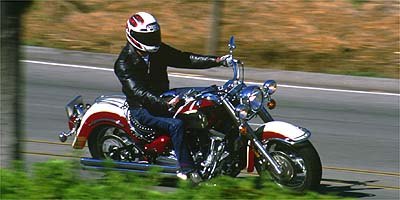2000 Yamaha Road Star - Motorcycle.com
Torrance, California, August 17, 2000 -- We only know one person who makes it a point to be just one of the masses -- he's still trying to latch onto the next comet-watching, grape juice-swilling, tree-hugging cult he can find. Luckily, he's not on our staff. Unfortunately, he's not incarcerated yet, either. But that's not the point of this story.
Clones are bad news; recent improvements in science have taught us this. For instance, despite being so outwardly similar, Yamaha's Road Star is cheaper than Harley-Davidson's Fat Boy, it's nearest competitor. Despite similar performance, a lower retail price was the only real defense we had against our Harley-riding brethren on how the Road Star beat out the 'Boy in the shootout that saw the teacher become the student. Yes, grasshopper?
In the days following, in our Reader Feedback, the typical argument would look something like this:
Brethren : The Harley's got more resale value, guys.
Us : Okay, but what if we don't want to sell it?
Brethren : If you don't want to sell it, then at least you're riding a Genuine Piece of America!
Us : Um, look at our clothes, I don't think we really care what other people think about us. And aren't a number of those parts made in Japan now?
Brethren : Alright, but at least the Fat Boy'll have way more aftermarket support then your Yamaha.
Us : Yea but, Akrapovic makes this great pipe for. oh wait. wrong Yamaha.
To feed the increased displacement, a 42mm Mikuni Flatside carb replaces the stock 40mm CV carb and breathes through a free flowing air filter. Then, to top it all off, the cylinder head received some attention that allows an even larger increase in flow and, thus, power. Finally, the use of Vance & Hines "Long Shot" full exhaust system makes sure burned gases get properly dealt with on their way out.
Incorporating all four elements allowed a synergistic effect to occur, producing a motorcycle with a noticeable increase in usable power that would not have been found had only one or two modifications been made. However, with all this newfound power, the stock "black-box" was not up to the task of powering the new pump. The next thing we noticed was an item we criticized on the stock unit: The paltry redline experienced before had been fixed with Kudos going to a new Dyna 2000 Ignition. This "black-box" has settings for 10 unique throttle maps as well as the ability to increase the redline to 5,000rpm.Most of the upgrades and chrome goodies found on this bike are all straight from the Yamaha catalog. The exceptions are the Vance & Hines exhaust system, pistons, air-flow upgrade parts and ignition box. The pistons, carb and air-filter kit, as well as the ignition box were provided by Patrick Racing (714-554-7223). We feel these are definitely worth their weight in gold, er, chrome and should be high up on the list of "must-haves". On the otherlist are the floorboards. While the original floorboards kept the vibration off the rider's feet, the new billet units did no such thing. Once again, the ever-present comfort vs. performance (or in this case "customance") rears its ugly head.
Another "customance" fatality is in the new seat. Don't get us wrong, the very attractive (and lower) seat still remains comfortable for most cruising endeavors. However, our problem is with the lack of a pillion pad. After all, what's the point in impressing a possible future wife (or "life partner") if you can't take 'em for a ride? Nevertheless, if you're going for the solo-scene, then at least lose the passenger pegs. However, the stock pillion pad will fit at the sacrifice of "cool" points. This is a cruiser hop-up, so most of our complaints are subjective and you may actually like the floorboards. Then again, you may like to cruise up ad down the strip by yourself with the only companionship being the bear-hug embrace of "Hoss" your riding buddy. However, one "trait" that stood out as being universal was the brash indifference toward lawful society the Long Shot pipes produced. If the saying, "loud pipes save lives" holds even a thimble full of water, then anybody riding a big bore bike with these pipes will live forever.Loud pipes aside (even if they do "fit" this particular machine), what Yamaha was able to put together with only a small amount of outside help is very impressive. Churning out 69.2 hp and 99.9 pound feet of torque in a customized package that turns heads, tears up tires and still costs less than an off-the-rack Harley? That makes our eyes light up pretty bright. How 'bout you?
More by MO Staff


































Comments
Join the conversation